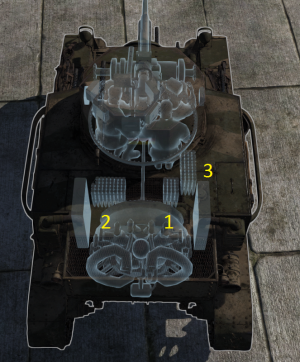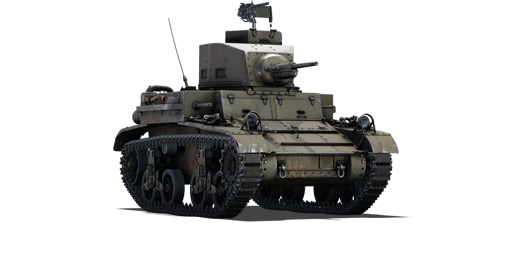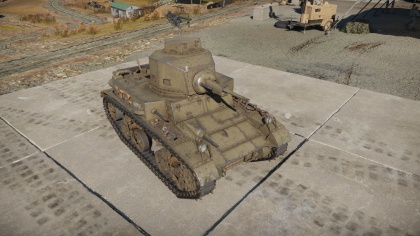Difference between revisions of "M2A4"
m (→Development) (Tag: Visual edit) |
m (I added a few notes about the tank which I noticed from playing the game and using this tank.) (Tag: Visual edit) |
||
| Line 38: | Line 38: | ||
* Suspension wheels are 15 mm thick, tracks are 10 mm thick. | * Suspension wheels are 15 mm thick, tracks are 10 mm thick. | ||
| + | * This is the weekest tank in the USA ranks. | ||
| + | * It is easily penetrated by others. | ||
| + | * It is fast, but hast problems with climbing steep hills. | ||
| + | * If you get imobilised you are as good as dead because this tank is to week to keep you runing when you get to higher ranks | ||
=== Mobility === | === Mobility === | ||
Revision as of 12:34, 20 January 2020
Contents
| This page is about the American light tank M2A4. For other uses, see M2 (Disambiguation). |
Description
The Light Tank M2A4 is a reserve rank I American light tank
with a battle rating of 1.0 (AB/RB/SB). It was one of the first American tanks to be released with the American ground tree in Update 1.45 "Steel Generals". The first iteration of the "Stuart" series, it is a simple design with a 37 mm tank gun and speed on its side.
General info
Survivability and armour
Armour type:
- Rolled homogeneous armour
- Cast homogeneous armour (Gun mantlet)
| Armour | Front (Slope angle) | Sides | Rear | Roof |
|---|---|---|---|---|
| Hull | 25.4 mm (19°) Front plate 15.8 mm (69°) Front Glacis 25.4 mm (20°) Lower glacis |
25.4 mm | 25.4 mm Top 25.4 mm (18°) Bottom |
6.35 mm |
| Turret | 25.4 mm (11°) Turret front 25.4 mm (12-65°) Gun mantlet |
25.4 mm | 25.4 mm | 6.35 mm |
| Armour | Sides | Roof | ||
| Cupola | 25.4 mm | 6.35 mm |
Notes:
- Suspension wheels are 15 mm thick, tracks are 10 mm thick.
- This is the weekest tank in the USA ranks.
- It is easily penetrated by others.
- It is fast, but hast problems with climbing steep hills.
- If you get imobilised you are as good as dead because this tank is to week to keep you runing when you get to higher ranks
Mobility
| Mobility characteristic | ||
|---|---|---|
| Weight (tons) | Add-on Armor weight (tons) |
Max speed (km/h) |
| 11.5 | N/A | 63 (AB) |
| 57 (RB/SB) | ||
| Engine power (horsepower) | ||
| Mode | Stock | Upgraded |
| Arcade | 406 | 500 |
| Realistic/Simulator | 232 | 262 |
| Power-to-weight ratio (hp/ton) | ||
| Mode | Stock | Upgraded |
| Arcade | 35.30 | 43.48 |
| Realistic/Simulator | 20.17 | 22.78 |
Armaments
Main armament
| 37 mm M5 | |||||
|---|---|---|---|---|---|
| Capacity | Vertical guidance |
Horizontal guidance | |||
| 103 | -6°/+19° | ±180° | |||
| Turret rotation speed (°/s) | |||||
| Mode | Stock | Upgraded | Prior + Full crew | Prior + Expert qualif. | Prior + Ace qualif. |
| Arcade | 19.52 | 27.01 | 32.80 | 36.27 | 38.59 |
| Realistic | 12.20 | 14.35 | 17.42 | 19.27 | 20.50 |
| Reloading rate (seconds) | |||||
| Stock | Prior + Full crew | Prior + Expert qualif. | Prior + Ace qualif. | ||
| 3.77 | 3.33 | 3.07 | 2.90 | ||
Ammunition
| Penetration statistics | |||||||
|---|---|---|---|---|---|---|---|
| Ammunition | Type of warhead |
Penetration in mm @ 0° Angle of Attack | |||||
| 10m | 100m | 500m | 1000m | 1500m | 2000m | ||
| M74 shot | AP | 66 | 65 | 55 | 46 | 38 | 31 |
| M51 shot | APC | 66 | 65 | 55 | 46 | 38 | 31 |
| Shell details | |||||||||
|---|---|---|---|---|---|---|---|---|---|
| Ammunition | Velocity in m/s |
Projectile Mass in kg |
Fuse delay
in m: |
Fuse sensitivity
in mm: |
Explosive Mass in g (TNT equivalent): |
Normalization At 30° from horizontal: |
Ricochet: | ||
| 0% | 50% | 100% | |||||||
| M74 shot | 792 | 0.87 | N/A | N/A | N/A | -1° | 47° | 60° | 65° |
| M51 shot | 792 | 0.87 | N/A | N/A | N/A | +4° | 48° | 63° | 71° |
Ammo racks

| Full ammo |
1st rack empty |
2nd rack empty |
3rd rack empty |
Visual discrepancy |
|---|---|---|---|---|
| 103 | 69 (+34) | 35 (+68) | 1 (+102) | No |
Machine guns
| 7.62 mm M1919A4 | ||||||||||||||||||||
|---|---|---|---|---|---|---|---|---|---|---|---|---|---|---|---|---|---|---|---|---|
| Coaxial mount | ||||||||||||||||||||
| Capacity (Belt capacity) | Fire rate (shots/minute) |
Vertical guidance |
Horizontal guidance | |||||||||||||||||
| 5,250 (250) | 500 | N/A | N/A | |||||||||||||||||
| Pintle mount | ||||||||||||||||||||
| Capacity (Belt capacity) | Fire rate (shots/minute) |
Vertical guidance |
Horizontal guidance | |||||||||||||||||
| 3,000 (250) | 500 | -10°/+45° | ±90° | |||||||||||||||||
| Hull mount (#1) | Hull mount (#2) | Hull mount (#3) | ||||||||||||||||||
| Capacity (Belt capacity) | Fire rate (shots/minute) |
Vertical guidance |
Horizontal guidance |
Capacity (Belt capacity) | Fire rate (shots/minute) |
Vertical guidance |
Horizontal guidance |
Capacity (Belt capacity) | Fire rate (shots/minute) |
Vertical guidance |
Horizontal guidance | |||||||||
| 5,250 (250) | 500 | N/A | N/A | 5,250 (250) | 500 | N/A | N/A | 5,250 (250) | 500 | N/A | N/A | |||||||||
Usage in battles
The M2A4 light tank is the reserve tank for the USA. As such, it is very manoeuvrable and fast, being a light tank. However, it has many distinguishing features that make it a forgiving beginners tank.
The M2A4 is most comparable to a cross between a BT-5 and T-26. The M2 has slightly less mobility than the BT-5 while being a larger target and having better armour, like the T-26. The M2A4 also has a fast-firing 37 mm M5 cannon that can fire M74 or M51 shot, as well as the M61 shell.
Its gun has better accuracy than the majority of tanks on its rank, and its APC ammo retains its penetration at most ranges. This ability to hit rapidly from range and still penetrate in part makes up for the somewhat anaemic damage of the 37mm gun.
Like all tanks of this rank, it is lightly armoured and can be damaged or knocked out by any other vehicle from anywhere on the map. A useful tactic is to make use of its speed by engaging at range and then relocating when the fire gets too heavy around you.
Modules
| Tier | Mobility | Protection | Firepower | ||
|---|---|---|---|---|---|
| I | Tracks | Parts | Horizontal Drive | M51 shot | |
| II | Suspension | Brake System | FPE | Adjustment of Fire | |
| III | Filters | Crew Replenishment | Elevation mechanism | ||
| IV | Transmission | Engine | Artillery Support | ||
Pros and cons
Pros:
- Fast and agile
- Acceptable gun
- Fair armour all around
- Machine gun secondary armament allows for flexibility in taking out exposed SPAA and Tank Destroyers
- Roof mounted 30. calibre is quite effective at taking out unarmoured aircraft
Cons:
- Uneasy handling, prone to slide at high speeds
- Quite flammable, even when hitting from the front
- Terrible steering, not adequate under 2nd gear
- Driving this straight into a wall at a fast speed can result in a crew knock out
- Can struggle to destroy larger vehicles due to lack of explosive filler
History
Development
The M2 Light Tank series was an American pre-World War II design as their answer to a fast, effective tank in a cavalry role.
The idea of light tanks started with the Defense Act of 1920, which defined tanks as an infantry support weapon. However, multiple theorists brought up the idea of a cavalry role for the tanks to which the British were the first to incorporate with the cruiser tanks. Limitation in American development leads to the establishment of light tanks as the combat cars. The development team soon looked at the tank prototypes T1 light tank and the T2 medium tank from which they decided to use them as the basis for the light tank design.
Modifications made onto the experimental tanks including installing the new Vertical Volute Spring Suspension (VVSS) which became the main suspension in future American tank development, made the tanks into the M2A1 light tank. The main version used before the war was designated the M2A2 and had two turrets, both with a .50 calibre M2 Browning machine gun as their armament. However, the Spanish Civil War demonstrated that this kind of light tank was insufficient for the ever-evolving tank warfare. Revising the armament of the tank, the two M2 Browning turrets were removed and replaced with a turret outfitted with a 37 mm cannon and improved armour. This became the M2A4 and served as the main light tank variant in US service prior to World War II.
Combat usage
Although the M2 light tanks were promising in their introduction, they were soon succeeded by the M3 and M5 light tanks. While development projects were in the works for bigger and better tanks, the M2 light tanks was a stopgap solution which filled a dire and immediate need for training crews and fielding tanks on the battlefield. By December 1941, the M2 light tanks were being used for training purposes only with the US Army, however, the US Marine Corps (specifically Company A, 1st Marine Tank Battalion) used a small number in combat during the Battle of Guadalcanal in the Pacific due to the lack of M3 light tanks available.
Britain ordered some M2 light tanks in early 1941 in part of the Lend-Lease Act, but only 36 were delivered before switching to the improved M3 light tanks.They were not used in combat.
A common feature on early US tanks were the large number of machine guns. Aside from the coaxial and the bow gunner's ball mounted gun, two machine guns were fixed facing forward on the sides of the hull, fired by the driver. Yet another M1919 Browning machine gun could be mounted on top of the turret in an anti-aircraft capacity.
In-game description
The M2 series traced its family tree back to the experimental T2s, with the M2A4 ending up the largest and most successful modification. Development began in 1939 after running trials for light tanks designed for infantry support as well as the M1 series. The M2 infantry tank was used as the base for construction, a model that was to undergo significant modification. The turret armor as well as the front end were thickened to 25 mm, capable of withstanding hits by light cannons and high-caliber machine guns.
The tank's weaponry was also improved with the installation of an M5 37 mm cannon paired with a 7.62 mm machine gun in the single turret. Another 7.62 mm machine gun was mounted in the front hull plate, with two more on the sides. An antiaircraft machine gun could be mounted on the top of the turret, and additional viewing slits were cut out of the turret and cupola. Most tanks featured the 360 hp Continental W-670-9A engine, which pushed their top speed to 56 km/h. Several tanks in the series were equipped with Guiberson T1020 diesel engines.
Given that September 1939 saw a spike in orders, the Rock Island Arsenal was no longer able to keep up on its own with the demand being placed on it by the US army. A tender for an additional batch was announced and won by American Car & Foundry. In October 1939 a contract for 329 tanks was signed, though it was soon expanded to 365. The last ten were assembled in April 1941 by Baldwin Locomotive Works, meaning that 375 M2A4s were produced in 1940.
The tanks only saw action on Guadalcanal and other Pacific islands. A few others were shipped to the UK via Lend-Lease and used there to train M3 medium tank crews.
Media
Skins and camouflages for the M2A4 from live.warthunder.com.
See also
Links to the articles on the War Thunder Wiki that you think will be useful for the reader, for example:
- reference to the series of the vehicles;
- links to approximate analogues of other nations and research trees.
External links
Official War Thunder forum article: [Vehicle Profile] M2A4 Light Tank
| USA light tanks | |
|---|---|
| LVT | LVT(A)(1) · ○LVT(A)(1) · LVT(A)(4) |
| M2 | M2A2 · M2A4 · M2A4 (1st Arm.Div.) |
| M3/M5 Stuart | M3 Stuart · M3A1 Stuart · M3A1 (USMC) · M5A1 · M5A1 TD · ▃Stuart VI (5th CAD) |
| M22 Locust | M22 |
| M24 Chaffee | M24 · M24 (TL) |
| M18 Hellcat | M18 GMC · M18 "Black Cat" · Super Hellcat |
| M41 Walker Bulldog | M41A1 |
| M551 Sheridan | M551 · M551(76) |
| M3 Bradley | M3 Bradley · M3A3 Bradley |
| Wheeled | M8 LAC · T18E2 · M1128 · M1128 Wolfpack |
| Other | M8A1 GMC · T92 · T114 · HSTV-L · CCVL · XM8 · XM800T · AGS |





